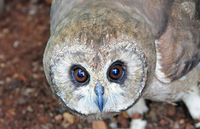Marsh owl
| Marsh Owl | |
|---|---|

| |
| Asio capensis capensis | |
| Scientific classification | |
| Kingdom Information | |
| Domain | Eukaryota |
| Kingdom | Animalia |
| Subkingdom | Bilateria |
| Branch | Deuterostomia |
| Phylum Information | |
| Phylum | Chordata |
| Sub-phylum | Vertebrata |
| Infraphylum | Gnathostomata |
| Class Information | |
| Superclass | Tetrapoda |
| Class | Aves |
| Sub-class | Neornithes |
| Infra-class | Neoaves |
| Order Information | |
| Order | Strigiformes |
| Family Information | |
| Family | Strigidae |
| Sub-family | Striginae |
| Genus Information | |
| Genus | Asio |
| Species Information | |
| Species | A. capensis |
| Population statistics | |
| Conservation status | Least concern[1] |
The marsh owl or cape owl (Asio capensis) is a species of owl of the family Strigidae, and found on the African continent and the nearby island of Madagascar.
Description
Marsh owls are medium-sized, about 11.4 to 14.9 inches in length. Females are larger than males. Like other owls in its genus the marsh owl bears ear tufts, but they are so small and inconspicuous as to be missed during field observations. The facial disk is pale brown with a dark, conspicuous border along the edge. The entire body plumage is an earth-tone color, with the underside lighter in tone with a fine speckle.
Subspecies
- Asio capensis capensis; Senegambia to Ethiopia and South Africa (patchy distribution)
- Asio capensis hova; Madagascar
- Asio capensis tingitanus; northwestern Morocco
Range and habitat
The range of the marsh owl is not contiguous. An isolated population lives in Morocco, and further populations are found south of the Sahara, where it is found in the Senegal river basin east to Ethiopia, southwards to South Africa. Individual populations south of the Sahara also show migratory movements, with individuals observed in the southern Iberian peninsula of Europe and in the Canary Islands. These movements are usually the expression of scarce food resources or reaction to bush fires and floods.
Marsh owls live in open landscapes with sparse tree cover, savannahs, and marshlands. It is generally not found in forested areas, rocky landscapes, or in deserts.
Diet
Marsh owls are active at dawn and night, with daytime activity sometimes occurring during cloudy days. Outside the breeding season it can occasionally be observed in small groups.
Diet is variable. As a rule, small mammals make up the bulk of their prey, among them mice, voles, rats, young hares, and bats. Birds up to the size of small ducks and pigeons are taken, as well as frogs, reptiles, beetles and grasshoppers.
Reproduction
Marsh owls are territorial during the breeding season, with aggressive behavior displayed in the vicinity of the nest. The nesting time starts with the dry season, with three to as many as six eggs being laid over the course of two days. Incubation is done by the female alone for about 27 to 28 days. The chicks are able to leave the nest within 70 days of hatching.